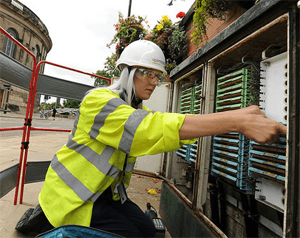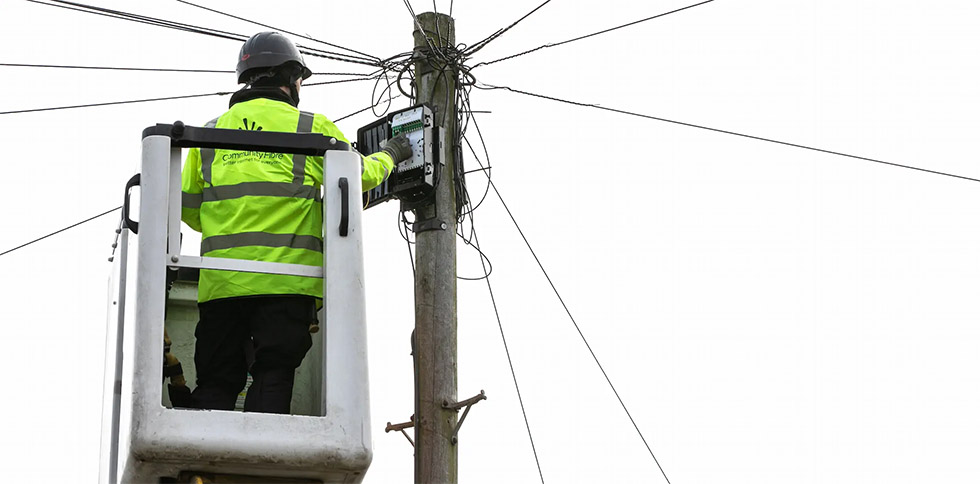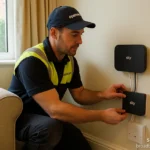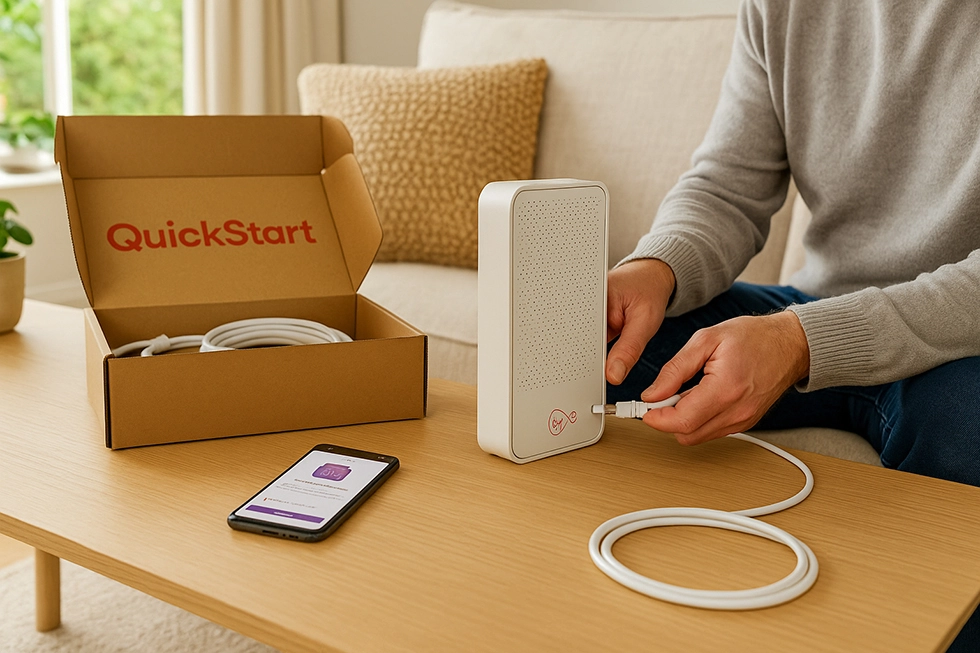Openreach has released its October 2025 update on the Fibre-to-the-Premises (FTTP) rollout. This update does not announce a new wave of towns or cities but instead refreshes the status of locations already included in the commercial plan. Each exchange is listed by its current stage of development, whether it is building, scheduled to build soon, planned for the future, marked as build finished, or designated as stop-sell active.

Stop-sell status is triggered when fibre is available to at least 75% of premises connected to a specific exchange. Once this threshold is reached, copper broadband packages such as ADSL and FTTC can no longer be ordered, and all new lines must use full fibre.
This is a key part of Openreach’s long-term transition from copper to fibre and ties into the nationwide copper switch-off programme. The switch-off is due to complete in 2027, when the public switched telephone network (PSTN) is withdrawn and all broadband and voice services move onto digital IP-based connections.
Coverage and take-up
Openreach’s full fibre network has now reached 20 million premises across the UK. The rollout is progressing quickly, with more than one million additional homes and businesses being connected every three months. This pace makes it one of the largest fibre deployment programmes in Europe.
Take-up of the new service currently averages 38% in areas where FTTP is available. In locations where fibre has been in place for a longer time, adoption rates are already climbing above 50%, showing a steady shift away from copper broadband.
This progress keeps Openreach on track to meet its short-term goal of covering 25 million premises by December 2026. Hitting this target will mean that a majority of UK households will have access to gigabit-capable broadband, supporting the wider national target of achieving near-universal gigabit coverage later in the decade.
Ofcom’s upcoming decisions will set direction
Beyond the 2026 target, Openreach has set out a longer-term ambition to extend its fibre network to 30 million premises by 2030. Achieving this would bring fibre to nearly the entire UK, given there are around 33 million premises nationwide.
Whether this goal is reached will depend heavily on regulatory and government decisions. Key factors include how much flexibility Openreach is given on wholesale pricing, how competition is managed, and what kind of planning or tax support is available to encourage further investment.
The most important decision point will be Ofcom’s Telecoms Access Review (TAR) for the 2026–2031 period. This review will determine the framework for fibre investment and competition over the next five years.
Ofcom’s final outcome is expected in March 2026. Until then, operators like Openreach are unlikely to commit to major new phases of rollout beyond the 25 million target. The ruling will effectively shape how fast and how far the next stage of fibre deployment can go.
What speeds are available
The Openreach fibre network today is built mainly on GPON technology, which has been the industry standard for many years. Using this platform, Openreach offers wholesale packages with download speeds of up to 1.2Gbps and 1.8Gbps. Upload speeds on these plans are typically around 120Mbps, which is more than enough for cloud storage, video calls, and remote working.
In certain Project Gigabit-funded areas, Openreach is also offering symmetric 1Gbps connections. These services deliver the same speed in both directions, making them well suited for households or businesses that upload as much data as they download, such as media creators or companies relying on cloud applications.
Looking ahead, the network is moving towards XGS-PON technology, which supports much faster speeds and greater capacity. Openreach has announced a large-scale trial in Guildford, starting in early 2026, that will involve about 40,000 premises.
This trial will test new broadband packages capable of reaching up to 8.5Gbps download speeds, with the potential to also support much higher uploads. If successful, it will mark the next major step in bringing multi-gigabit broadband to UK homes and businesses.
Reading the new build plan
The October update highlights progress across thousands of towns, cities, villages and hamlets. It gives a snapshot of where work is underway, where it is due to begin, and where exchanges are already complete.
However, being listed in the plan does not guarantee that every household or business in that location will be connected. Fibre rollout is complex, and engineering challenges such as blocked ducts, wayleave issues, or unexpected build costs can lead to delays. In some cases, premises may even be left out entirely if the cost of connection proves too high.
For that reason, the plan should be seen as indicative rather than absolute. Locations can move between categories, be paused, or in some cases removed and replaced by others.
It is also important to note that the published build plan only reflects Openreach’s commercial programme. Other projects such as infill work, retrofitting, or connections built under government-backed Building Digital UK (BDUK) contracts are not included in this list. These additional programmes are often designed to cover harder-to-reach rural properties and can fill gaps left by the commercial rollout.
Investment and workforce
Openreach currently employs around 15,000 people who are dedicated to building and maintaining its full fibre network. This workforce includes engineers working on street cabinets and fibre splicing, planners who design the network routes, and support staff who manage the rollout across the country.
The scale of investment remains significant. On average, it costs about £280 to connect each property to the fibre network. When multiplied across the pace of rollout, this equates to more than £1.2 billion of spending every year.
This level of investment makes the programme one of the largest civil engineering projects underway in the UK. It also shows how central fibre broadband has become to the country’s digital infrastructure, with ongoing spending aimed at meeting both commercial targets and wider government goals for gigabit connectivity.
What this means for households and businesses
Full fibre is not something customers are switched to automatically. Even if fibre cables are available outside a property, an order still needs to be placed with a broadband provider. Openreach supplies the network on a wholesale basis, and major ISPs including BT, Sky, TalkTalk, Vodafone and many others use it to offer their fibre packages.
Some providers have started to migrate existing customers onto fibre at no extra cost, especially in areas where copper-based broadband is being withdrawn. This helps smooth the transition ahead of the national copper switch-off in 2027, but it is still not universal. Most households will need to actively choose a fibre plan if they want to upgrade.
For homes, fibre offers faster speeds and a more reliable connection that does not slow down during peak hours. This makes it well suited for streaming, gaming, and households with multiple devices online at once.
For businesses, the benefits go further. Higher bandwidth and lower latency support cloud-based tools, video conferencing, large file transfers, and other data-heavy services without disruption. Fibre also provides the capacity needed for future digital applications, ensuring that offices remain connected as demands increase.
Comparing Openreach with altnet providers
While Openreach pushes ahead with its national rollout, a growing number of alternative networks are also expanding fibre across the UK. These companies, often referred to as altnets, include providers such as CityFibre, Community Fibre, Hyperoptic, Gigaclear and others. Collectively, they now cover millions of premises and are competing directly with Openreach in many towns and cities.
A key difference is that many altnets are building their networks with XGS-PON technology from the outset. This allows them to offer symmetric gigabit services, where upload and download speeds are the same. In some cases, they are already introducing multi-gigabit packages, with speeds well above 1Gbps.
This competitive push is reshaping the broadband market. Consumers and businesses now have more choice than ever before, but it also means operators are under pressure to keep prices attractive and services up to date.
It is one of the reasons why Ofcom’s upcoming Telecoms Access Review carries so much weight. The regulator’s decisions will set the framework for how Openreach and altnets compete, and whether the market can sustain multiple large-scale fibre builders in the years ahead.










